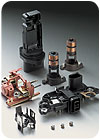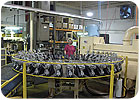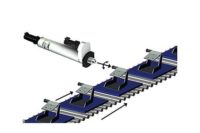
Back in the good old days, college football games were played on Saturday afternoon and nearly every town in America had a small, family-owned hardware store. Machine shops made metal parts and injection molders mass-produced plastic parts. The components were then shipped to plants where they were assembled into various subassemblies and final products.
Today, there are college football games almost every day of the week and independent hardware stores are extremely rare. Many upstream manufacturing operations are now assembling the parts that they make as a value-added service for their customers. As a result, the traditional lines between OEMs and suppliers are slowly blurring.
Several forces are driving this trend. First, manufacturers in all industries are attempting to squeeze costs so that they can compete more effectively with overseas competition. Domestic injection molders and metal cutters are also scrambling to find ways to add value to their product. At the same time, lean manufacturing initiatives preach about the importance of waste reduction and efficient supply chains.
Upstream assembly is an evolving paradigm that’s changing traditional manufacturing roles and operating philosophies. The goal is to assemble as many individual parts as possible into subassemblies at the same location where the parts are initially made. This trend started in the auto industry, but has trickled down to other industries, such as aerospace and medical devices. Parts of smoke detectors, lunch boxes, cell phones and other consumer goods are also assembled by upstream suppliers that produce plastic parts.
Many observers claim that more and more machine shops, injection molders and die casters are assembling parts today. “We started to see this movement about 5 years ago, but it has accelerated over the last couple of years,” says Larry Stockline, president of Promess Inc. (Brighton, MI). “It’s opening up new avenues to people that only did one thing before-they passed on the parts they made to another supplier or to a manufacturer.”

New End User Demands
According to Stockline, upstream assembly activity is being fueled by demands from the end user. Everyone wants fewer suppliers in today’s more complex, time-sensitive world.“The longer the supply chain, there’s more risk and finger-pointing related to warranty and liability,” notes Stockline. “The shorter the link in the supply chain, they stronger it is. One of the many ways to fight global competition is to push each supplier to [maximize product content. Upstream assembly] is changing the landscape of suppliers and types of suppliers, and it will only pick up speed in the future.”
“It’s occurring everywhere,” adds Bob Rice, applications team leader at Automation Tool Co. (Cookeville, TN). “We’ve seen it in the automotive industry, which has driven toward larger and larger subassemblies for years. And, in the medical industry, so many parts are [made out of] disposable plastics [that device manufacturers are looking] toward the molder to supply subassemblies or even finished product.”
“More and more companies that typically were just plastic injection molders and machine shops are taking on more of a contract manufacturer role, and providing more value-added services,” explains Jesse Hayes, product manager for automation components at Schunk Inc. (Morrisville, NC). “I view it as a form of outsourcing.”
Hayes believes it makes sense for the guys who make parts to also put them together whenever possible. “There are benefits for both sides,” he points out. “It is a good way for the end manufacturer to achieve cost savings with less direct overhead, while these new ‘contract manufacturers’ can gain more revenue out of the product they are supplying with this service.”
Large and small companies are offering a wide variety of post-mold and post-machine services, including assembly. Consider just a few examples from different parts of the country:
Automation Plastics Corp. (Aurora, OH), which specializes in injection-molded parts for aerospace, appliance, automotive, consumer goods and medical device applications, provides subassembly of parts prior to shipment as a value-added service.
Bitec Sample Machining Inc. (Dayton, OH), a traditional machine shop that specializes in making metal parts for aerospace, defense and agricultural equipment manufacturers, now offers assembly and test services.
G.S. Precision Inc. (Brattleboro, VT), a 50-year-old machine shop that serves aerospace, automotive and medical manufacturers, claims that it has “the capability to produce a wide variety of subassemblies that require heading, stamping, flaring, press work, riveting and installation of inserts.”
Tech Mold Inc. (Tempe, AZ), which specializes in high-precision injection molds for the medical device industry, boasts that it offers “integrated capabilities in contract molding and final assembly.”
“It’s real tough for a lot of traditional machine shops and injection molders to make money today, because of intense foreign competition,” says Malcolm Mason, business development director at the Association for Manufacturing Technology (AMT, McLean, VA). “And, thanks to more flexible CNC machines and better controls, fewer machines can produce more parts than in the past. With more time and more floor space available, that opens the door for new services, such as assembly. As many companies look around for ways to supplement traditional metal-cutting or molding activity, they see numerous opportunities in assembly.”
Jack Stanley, business development manager at Feintool Plastic/Metal Components Inc. (Antioch, TN), believes upstream assembly may be a natural progression based on new technology and new processes, such as insert molding. “Several different metal and plastic components can now be molded into one component,” he points out. “That helps reduce the number of parts in a subassembly and drives cost out of the parts process.”
A Bold New Era
Upstream assembly traces its root to the auto industry and its tiered supply system. According to Stockline, the initiative to push assembly upstream started with automakers’ efforts to reduce their number of suppliers. “On the surface, it was assumed that these were redundant suppliers,” he explains. “[However], remaining suppliers were told to join with former suppliers or add content to the product they were supplying.”The days of vertical integration are over. Automakers now manufacture fewer components internally than in the past. While they still build their own engines and drivetrains, that core competency may eventually be outsourced, like seats, instrument panels, front ends and other subassemblies.
Automakers already outsource some critical powertrain components to upstream suppliers. For instance, consider the Northstar V-8 engine, which is used in Buick and Cadillac sedans. The engines are assembled at a General Motors Corp. (GM, Detroit) plant in Livonia, MI, but a key component is assembled across town at a Tier Two supplier that casts and machines metal powertrain parts for several different automakers.
The water crossover assembly houses a water pump that dispenses coolant throughout the engine to keep it at an optimum operating temperature. The 28-pound device also contains the throttle body, which meters the air flow allowed into the intake manifold. In addition, the water crossover assembly houses the exhaust gas recirculation valve.
The subassembly contains more than 50 parts. After the parts are assembled by the supplier, the water crossover assembly is tested and inspected to reduce the risk of quality bottlenecks downstream. In the past, all those individual parts were shipped to the GM engine plant, where they were assembled.
According to Stockline, the current role model for upstream assembly is Boeing Co. (Chicago). The company once claimed to operate the largest machine shop in the world. Today, Boeing prides itself on lean manufacturing.
More than 50 percent of its product is made outside of the company’s plants, “with as much content as possible with each supplier,” notes Stockline. “In many cases, a Boeing quality control team is resident full time at the supplier to assist in flow and product performance. Only final, final assembly is done at Boeing.”
For instance, the aerospace manufacturer is farming out major chunks of its new 787 Dreamliner to upstream companies that are assembling the wing and fuselage sections. Instead of building those huge subassemblies itself, as it has in the past, Boeing is now acting more like a systems integrator.
When production ramps up next year, each 787 will only spend 3 days on the company’s final assembly line vs. 1 month for traditional airliner assembly. In fact, the vertical fin is the only piece of the airframe that’s actually being built by Boeing employees. Everything else is outsourced to companies in Kansas, South Carolina, Japan and Italy. Fuselage and wing sections are transported to the final assembly line by modified 747 cargo planes.
However, the Boeing and GM examples above tend to be the exception rather the rule. Most upstream assembly activity involves 10 parts or fewer. Typically, machine shops and injection molders are only assembling four or five parts at a time, and the subassemblies are not too complex.
For instance, a plastic injection molder may also be inserting springs into syringes and other disposable medical devices. Or, a company that machines bearings for suspensions may now build an entire rocker arm subassembly. Every little bit extra helps eliminate several production steps for their customers, and makes cutters, molders and stampers act more like single-source suppliers.
Numerous Benefits
Upstream assembly offers numerous benefits to manufacturers, including cost-efficiency, streamlined production, inventory reduction and reduced time-to-market. Asking parts makers to do more than just make parts makes economic sense today. With 40 percent to 70 percent of costs typically embedded in the supply chain, any effort to streamline production can reap huge benefits for manufacturers.Each application varies in the benefits it offers. However, “cost is and will always be the No. 1 issue,” says Chuck Rupprecht, executive vice president of BalTec Corp. (Canonsburg, PA). “If a vendor can perform a secondary operation on the part that is being supplied, this eliminates process steps at the customer site, reduces work in process inventories, and allows for a just-in-time process to become more effective. You just can’t produce parts any more; you have to offer some sort of value-added service.”
“Requesting upstream suppliers to assemble components can help manufacturers greatly reduce the cycle time and throughput time of the final assembly process,” adds Richard Ligus, president of Rockford Consulting Group (Rockford, IL), who recently worked with a motor control drive manufacturer on this issue. “This results in lower unit costs, from labor and overhead, and shorter lead times, which provide the final assembler with a competitive advantage.”
According to Jamie Flinchbaugh, a partner in the Lean Learning Center (Novi, MI), some upstream suppliers may also pay their employees less than OEMs, which can be advantageous if they pass along those cost savings. “If I can get the machine shop to add a seal to a machined part at a lower price, it’s a decent deal,” he points out.
“It’s also important to look at the value stream-in particular, the start and stop of production processes,” says Flinchbaugh. “If I take a part out of an injection mold machine, then put it in a box, then take it out of a box, then move it to a subassembly table, then add something to it, then move it to an assembly line, then assemble [it into a product], there is a lot of waste. If I take it out of the machine, add a component right there, then put it in a box, then remove it from the box on the assembly line and assemble, it isn’t perfect, but it is a lot better.”
Other advantages of upstream assembly include reduced inventory, which can simplify logistics and shipping. If an OEM only has to track one assembly, then packaging and shipping costs are greatly reduced.
“One assembly product number is better than many individual numbers to track,” says Dave Hayes, product manager at Haas Automation Inc. (Oxnard, CA), a leading supplier of CNC machine tools, who says he sees more manufacturers trying to shift some of their core subassembly burden to suppliers.
“In many cases, they have the leverage to insist that their suppliers do this at very specific costs,” notes Hayes. “The suppliers may reluctantly agree, only to maintain the machining parts business, as many are not set up to do assembly.”
Upstream assembly can also help streamline production. For instance, plastic injection-molding equipment is widely used to manufacture numerous medical devices.
“The industry realized that at the time of molding, the part is oriented,” says Len Czuba, president of Czuba Enterprises Inc. (Lombard, IL), a product design firm that specializes in plastic medical devices. “If assembly is needed, the part can be picked from the mold, conveniently moved to an assembly station and combined with another component in an assembly station.
“When the overall process is examined, it becomes apparent that automation can offer some great improvements over conventional processes of making parts, shipping these parts to an assembly plant, and having someone else make the finished medical device,” Czuba points out. “There is no chance for a part to be contaminated, broken or otherwise damaged during the shipping and handling if it is immediately taken from a mold and assembled before it ever touches another surface. This is a very big advantage, and the overall cost savings when it is done correctly can be significant.”
Upstream Challenges
Despite all the benefits of upstream assembly, several challenges must be addressed, such as quality and employee training. The type of parts to be assembled also must be taken into consideration. Understanding the assembly processes involved is extremely important.“If it is a simple process, such as riveting a ball stud to a stamping, it makes sense and can be easily accommodated,” says Rupprecht. “However, more complex assemblies that require multiple processes need to be analyzed on a case by case basis, based on the level of competency of the producer and the investment required to perform the operation.
“The challenges could be minimal or significant, based on the complexity of the part and the overall cost pressures that the manufacturers are subjected to,” adds Rupprecht. “Many issues, such as training, capital investment, facilities, engineering and quality, need to be considered in providing any type of value-added secondary service or process.”
According to AMT’s Mason, volume also should be taken into consideration. “Upstream assembly makes more sense for high-volume production and for products with long life cycles,” he points out. “It makes less sense for batch processes.”
As a machine shop or injection molder evolves from its core competency to assembly, the ability to handle additional components can be daunting. “When moving from just machining components to also pressing components together, fastening components together and testing assembled components, maintaining quality can be a challenge,” notes Don Burnard, business development manager at Cincinnati Automation & Test (Machesney Park, IL).
“Many challenges await those who venture into upstream assembly,” warns Burnard. “Typically, the machine shop or injection molder does not have an assembly guru on staff and has to rely on internal staff that is limited in knowledge. In some cases, our customers have actually hired assembly-specific personnel to help migrate the company beyond their core offering.”
Upstream assembly also creates challenges and opportunities for equipment vendors. For instance, many machine shops and injection molders are not familiar with basic assembly processes or machines, such as presses and ultrasonic welders. That creates an opportunity for suppliers to educate them.
“Many traditional machine shops are normally not set up or prepared to do this,” says Schunk’s Hayes. “They must invest in new equipment, train existing personnel or hire new people, set up new inspection stations, and investigate the entire process from start to finish. They need a lot of extra hand-holding.
“But, I see it as a good opportunity for automation,” adds Hayes. “As these suppliers take on the assembly of their supplied products, they will look to automation to become more efficient. However, as with any new process, there will be learning curves.”
Dave Zabrosky, president of Schmidt Technology Corp. (Cranberry Township, PA), says his company exhibited at the International Manufacturing Technology Show (IMTS) in Chicago last year. The event, organized by AMT, is a major trade show for the machine tool industry.
“We were at IMTS to see if the upstream assembly trend was, indeed, happening,” explains Zabrosky. “It was definitely an eye-opening experience. Many people who don’t know assembly were coming up to our booth and asking ‘How can I use this to do that?’
“In the old days, metal cutting was metal cutting, and assembly was assembly,” says Zabrosky, who once worked as a machinist at a tool-and-die shop. “But, that’s definitely no longer the case.”

